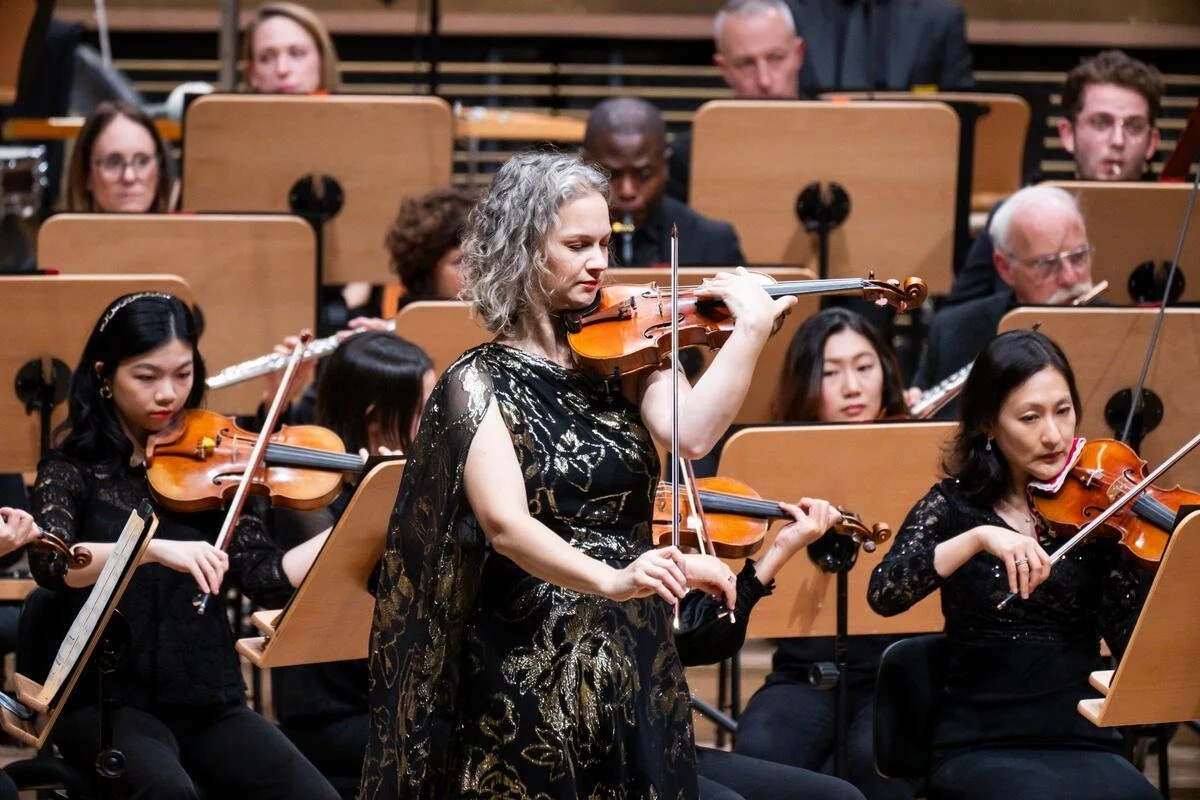REVIEW: Mozart Unscathed Despite Erratic Performance
Above photo by Stephanie Berger.
November 7, 2024
Is there a conductor in the house?
For Orpheus — New York’s 52-year-old democratic chamber orchestra that operates without a conductor — the answer is “no, thank you.” But, Maxim Vengerov, celebrated Soviet-Israeli violin virtuoso engaged as soloist in a two-concert survey of Mozart’s complete works for violin and orchestra at Carnegie Hall, apparently did not get the memo.
Mozart’s five violin concertos are relatively youthful works — not his most transcendent inspirations, but utterly delightful and generally sunny. Orpheus’s Mozart cycle culminated with the second concert, which featured the second and fifth concertos followed by one of the composer’s genuine masterpieces, the later Sinfonia concertante in E-flat Major, K. 364, for duetting violin and viola with orchestra. However, musical nirvana remained elusive in this strangely erratic performance.
The problem began with the programming notion. All three pieces are scored for the same orchestra: two oboes, two horns, and strings. Further, the pieces comprising this concert’s first half, Violin Concerto No. 2 in D Major, K. 211, and Violin Concerto No. 5 in A Major, K. 219, are in closely related tonal centers. This sounds monochromatic on paper, let alone for those sitting in the hall, and it was indeed an exercise in mindful modern listening.
Maxim Vengerov’s 1727 Stradivarius is nearly 50 years older than the two Mozart concerti on the program, composed in 1775, and he plays with a sterling, luxuriant tone, and dispatches showy scales and arpeggios with deceptive ease. The orchestra sounded beautiful. Their hallmark — playing orchestral repertoire like chamber music — hinges upon taking turns in the lead, and listening, listening, listening. Naturally, a warm blend and rounded intonation follows.
But, to play Mozart’s innocent and transparent concertos in intricate synchronicity requires a meeting of the minds between soloist and orchestra. Conventionally, the conductor would function as mediator, at times traffic cop; a conductor-less, salon-like approach is entirely possible — fully in the spirit of Mozart’s creations, even — yet evidently requires more rehearsal than the current budget afforded.
The Violin Concerto No. 2’s first movement, Allegro moderato, began with Vengerov hovering where the podium would be, fiddle and bow in arm, “conducting” the orchestral exposition. He gesticulated emphatically; Orpheus’s musicians appeared spoken to in a language they did not speak.* Vengerov relinquished conducting duties just in time to play, introducing a flute-like, whistling tone in dialogue with the first violins. Musical details such as dynamic tapers and shapely phrasing had clearly been well-planned and gracefully executed. The virtuoso soon succumbed to discontent with the tempo, pulling ahead, the upstage musicians bringing up the rear.
Vengerov’s first movement cadenza was playful and had a carefree build of momentum. The sweet second movement, Andante, was supported by delicate, diplomatic horn playing, and at first, Vengerov floated atop like a soprano. This aria-like movement’s cadenza was a winding detour of double-stops that wobbled and lost its footing, intonation-wise. The concluding Rondeau: Allegro was slightly strained in the upper register, finding solid ground momentarily in a brief, heartfelt passage in D minor.
Photo by Stephanie Berger.
The Violin Concerto No. 5’s first movement (Allegro aperto) was off to a great start, with a focused, energetic exposition featuring clear textures and styled edges from the orchestra. Vengerov’s entrance — a sudden shift to Adagio — abounded in operatic drama, but our heroine struggled to hold pitch, wobbling whenever not executing fast coloratura. The cadenza, while inventive and well-traveled, conflated insouciance and ease of use with imprecise finger-work and insecure harmonies.
The placid second movement (Adagio) again featured lovely playing from the orchestra, especially the oboes. Vengerov’s cadenza delved deeper here than elsewhere, venturing to distant chords that broke up the monotony, and featured his most compelling playing of the evening. The Rondeau: Tempo di menuetto, one of Mozart’s most danceable minuets, was another high point, soloist and ensemble in the pocket, especially in the bittersweet F-sharp minor episode. The A minor Allegro section that gives this work its nickname “Turkish” was appropriately rustic and nefarious; the cellos conjured a percussive effect for foot-stomping infectious rhythm, and slurring, exaggerated dynamics in swaying chromatic unisons was fun, if heavy-handed. .
Violist Lawrence Power was a towering, valuable addition for the Sinfonia concertante from 1779. Power’s rosy, woodsy timbre melded nicely with Vengerov’s, and they matched each other tête-à-tête in the Allegro maestoso. The abundant flow of ideas from Mozart’s pen poured forth with forward momentum, and turned reflective in the cadenza. Power accompanied Vengerov in smoky, shaded chords.
The slow movement in C minor, one of the highlights of Mozart’s ouvre, has a tempo marking of Andante, but has often been played more slowly than the word would imply. Vengerov clearly bristles at the dirge-like interpretation — instead pressing this reading to amble at a jaunty pace, signaling frequently to the orchestra to “keep it moving.”
But, rather than provide insight into the movement, it was just too fast. The mellifluous runs brimming from the violin and viola were compressed and cramped, and as a whole, the movement was bereft of tenderness and expressive pathos. Alas, the country dance of a finale (Presto) was even more of a ragged misfire.
Soloists and orchestra disagreed on the tempo from the start — there must have been half-a-dozen different tempos before the triumphant horns declaimed their affirmative call. It was a stressful battle, rather than a joyous finale. The performers knew as much — for an encore, they repeated the movement, after some instruction and demonstrating from the “conductor.”
The second attempt was a consolation. Vengerov obviously has a strong point of view about how these pieces should be played. However, the stars were not aligned, and perhaps, these pieces are not best served as one heaping marathon.
Photo by Stephanie Berger.
[*]:







